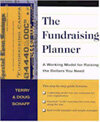The Fundraising Planner: A Working Model for Raising the Dollars You Need
At the trial of the Knave of Hearts in Alice in Wonderland, just before White Rabbit reads purported evidence against the Knave — who has been accused of stealing tarts — the rabbit asks the king, "Where shall I begin, please your Majesty?" the King answers, "Begin at the beginning and go on till you come to the end: then stop."
Sage advice for prosecutorial rabbits and for fundraisers. The most important step toward fundraising success is the first one — planning. Begin with planning, and you have laid a solid foundation for the success of any kind of campaign: capital, annual, endowment, and special project.
"Unfortunately, many fundraising efforts fail because the organization pays insufficient attention to creating a plan and monitoring its progress," write Terry and Doug Schaff. "A sound fundraising plan is your map and itinerary for raising the money your organization needs. It identifies your donors and prospects and your strategies for researching, cultivating, and soliciting them. It is your calendar of events, mailings, and strategies to attract contributions."
Whether you are new to fundraising or an experienced professional; whether you are a board member, volunteer, or employee, this book provides everything you need to create a plan that works for your organization. The Schaffs declare their approach to be a "working model," which means it is flexible and easily adaptable to your specific needs.
Their approach is clear and simple: name the fundraising tasks, determine who will do them, and create a timeframe for doing them, all developed through eight basic steps:
- Determine the funding need.
- Break the funding need into manageable parts.
- Build the case for support.
- Identify key donors.
- Select effective fundraising activities.
- Put the fundraising activities on the calendar.
- Schedule specific tasks to cause the fundraising activities to occur.
- Review and evaluate progress, making adjustments as needed.
In general, say the Schaffs, fundraising plans should be made for periods of twelve months at a time. Schedule an evaluation of your plans approximately two months before the end of your fiscal year, in preparation for planning for the coming year.
Each fundraising activity should name the person in charge of the activity, the financial goal, the targeted prospects, and the fundraising strategy to be used. Over and over, the Schaffs emphasize to put your activities on the calendar. Do not try to keep things in your head. Documentation will make planning and implementation for next year much easier, and your activities will be much more productive. A sample fiscal year fundraising schedule is in the book, along with dozens of helpful exhibits, figures, and to-do exercises.
Terry Schaff is a professional fundraiser and consultant. She is director of institutional advancement for the Poughkeepsie Day School in Poughkeepsie, New York. Doug Schaff has written grant proposals and fundraising literature for local and international organizations. He is the author of How to Make Money Investing Abroad.
Contents
Part One, The Fundraising Planning Model
1. Why You Need a Fundraising Plan
2. How the Model Works
Part Two, Understanding the Big Picture
3. Determining the Funding Need
4. Breaking the Funding Need into Manageable Parts
Part Three, Deciding Plan Inputs
Step One, Building the Case
5. Creating a Core Communication Piece
6. Selecting Case Support Materials
Step Two, Identifying Key Donors
7. Recognizing Potential Donors
8. Tracking and Evaluating Prospective Donors
9. Involving Your Board
Step Three, Selecting Effective Fundraising Activities
10. Planning Your Cultivation and Solicitation Activities
11. Finding Institutional Donors
Part Four, Putting the Plan Together
12. What Your Fundraising Plan Looks Like
Part Five, Monitoring the Plan
13. Evaluating Your Progress and Following Up
Appendix, The Internet: An Important Tool for Fundraisers
References








